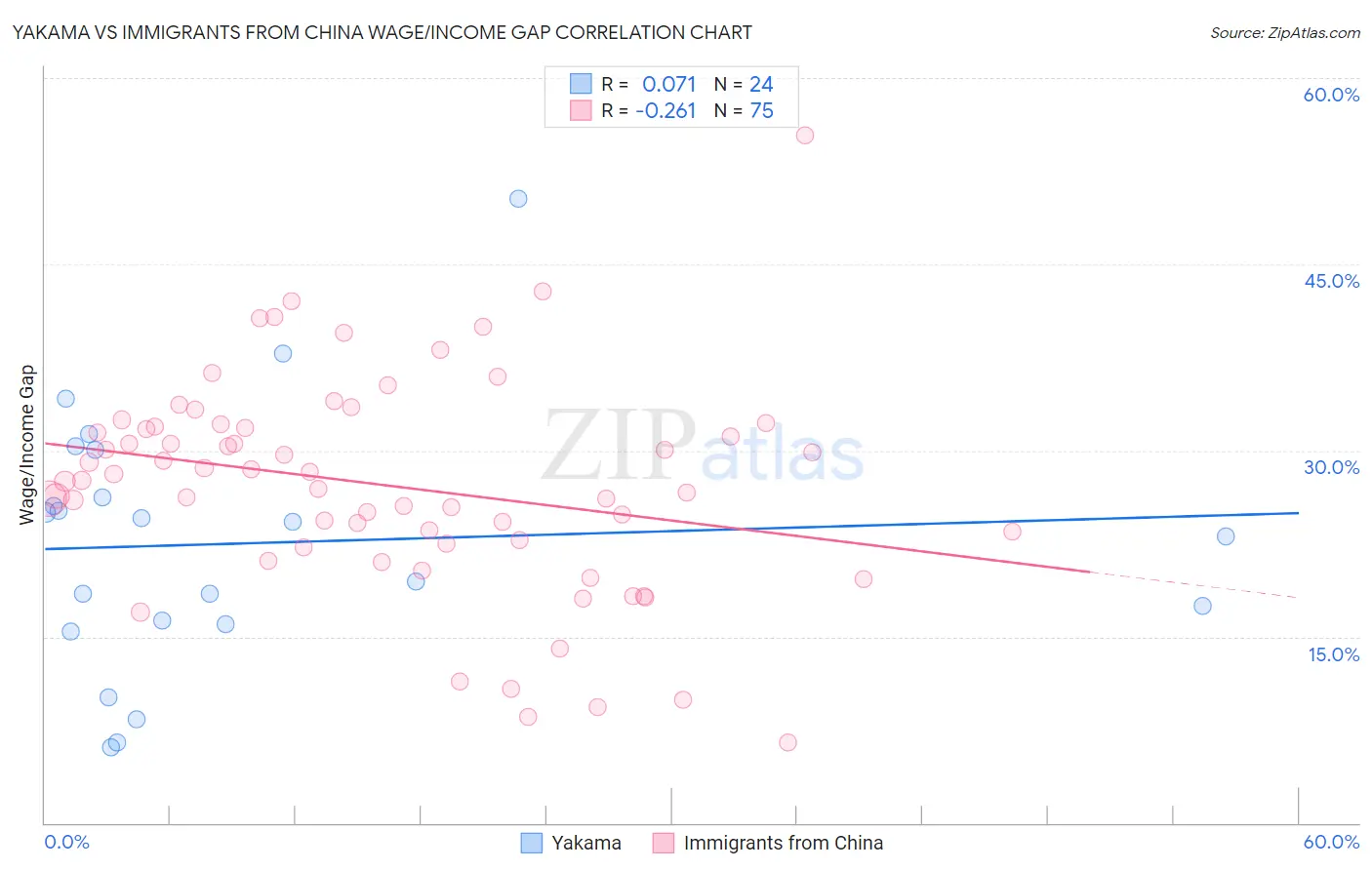Yakama vs Immigrants from China Wage/Income Gap
COMPARE
Yakama
Immigrants from China
Wage/Income Gap
Wage/Income Gap Comparison
Yakama
Immigrants from China
23.7%
WAGE/INCOME GAP
99.2/ 100
METRIC RATING
100th/ 347
METRIC RANK
26.7%
WAGE/INCOME GAP
10.3/ 100
METRIC RATING
214th/ 347
METRIC RANK
Yakama vs Immigrants from China Wage/Income Gap Correlation Chart
The statistical analysis conducted on geographies consisting of 19,909,304 people shows a slight positive correlation between the proportion of Yakama and wage/income gap percentage in the United States with a correlation coefficient (R) of 0.071 and weighted average of 23.7%. Similarly, the statistical analysis conducted on geographies consisting of 456,702,733 people shows a weak negative correlation between the proportion of Immigrants from China and wage/income gap percentage in the United States with a correlation coefficient (R) of -0.261 and weighted average of 26.7%, a difference of 12.3%.

Wage/Income Gap Correlation Summary
| Measurement | Yakama | Immigrants from China |
| Minimum | 6.1% | 6.5% |
| Maximum | 50.3% | 55.3% |
| Range | 44.2% | 48.9% |
| Mean | 22.5% | 27.2% |
| Median | 23.7% | 27.6% |
| Interquartile 25% (IQ1) | 16.2% | 22.4% |
| Interquartile 75% (IQ3) | 28.2% | 31.9% |
| Interquartile Range (IQR) | 12.0% | 9.5% |
| Standard Deviation (Sample) | 10.3% | 8.7% |
| Standard Deviation (Population) | 10.1% | 8.6% |
Similar Demographics by Wage/Income Gap
Demographics Similar to Yakama by Wage/Income Gap
In terms of wage/income gap, the demographic groups most similar to Yakama are Aleut (23.7%, a difference of 0.020%), Immigrants from Latin America (23.7%, a difference of 0.090%), Japanese (23.8%, a difference of 0.15%), Immigrants from Laos (23.8%, a difference of 0.30%), and Immigrants from Sudan (23.6%, a difference of 0.49%).
| Demographics | Rating | Rank | Wage/Income Gap |
| Immigrants | Cabo Verde | 99.5 /100 | #93 | Exceptional 23.6% |
| Hondurans | 99.5 /100 | #94 | Exceptional 23.6% |
| Cape Verdeans | 99.4 /100 | #95 | Exceptional 23.6% |
| Kiowa | 99.4 /100 | #96 | Exceptional 23.6% |
| Immigrants | Sudan | 99.4 /100 | #97 | Exceptional 23.6% |
| Immigrants | Latin America | 99.2 /100 | #98 | Exceptional 23.7% |
| Aleuts | 99.2 /100 | #99 | Exceptional 23.7% |
| Yakama | 99.2 /100 | #100 | Exceptional 23.7% |
| Japanese | 99.1 /100 | #101 | Exceptional 23.8% |
| Immigrants | Laos | 99.0 /100 | #102 | Exceptional 23.8% |
| Tsimshian | 98.9 /100 | #103 | Exceptional 23.9% |
| Tlingit-Haida | 98.7 /100 | #104 | Exceptional 24.0% |
| Moroccans | 98.6 /100 | #105 | Exceptional 24.0% |
| Sudanese | 98.6 /100 | #106 | Exceptional 24.0% |
| Yaqui | 98.4 /100 | #107 | Exceptional 24.0% |
Demographics Similar to Immigrants from China by Wage/Income Gap
In terms of wage/income gap, the demographic groups most similar to Immigrants from China are Immigrants from Iraq (26.7%, a difference of 0.010%), Yugoslavian (26.7%, a difference of 0.090%), Immigrants from Portugal (26.7%, a difference of 0.13%), Iraqi (26.6%, a difference of 0.16%), and Mongolian (26.6%, a difference of 0.19%).
| Demographics | Rating | Rank | Wage/Income Gap |
| Immigrants | Italy | 15.8 /100 | #207 | Poor 26.5% |
| Egyptians | 12.7 /100 | #208 | Poor 26.6% |
| Immigrants | Kuwait | 12.6 /100 | #209 | Poor 26.6% |
| Arabs | 12.3 /100 | #210 | Poor 26.6% |
| Mongolians | 11.4 /100 | #211 | Poor 26.6% |
| Iraqis | 11.2 /100 | #212 | Poor 26.6% |
| Immigrants | Iraq | 10.3 /100 | #213 | Poor 26.7% |
| Immigrants | China | 10.3 /100 | #214 | Poor 26.7% |
| Yugoslavians | 9.7 /100 | #215 | Tragic 26.7% |
| Immigrants | Portugal | 9.5 /100 | #216 | Tragic 26.7% |
| Brazilians | 9.2 /100 | #217 | Tragic 26.7% |
| Immigrants | Saudi Arabia | 9.1 /100 | #218 | Tragic 26.7% |
| Immigrants | Poland | 8.9 /100 | #219 | Tragic 26.7% |
| Immigrants | Latvia | 8.9 /100 | #220 | Tragic 26.7% |
| Immigrants | Spain | 8.5 /100 | #221 | Tragic 26.8% |